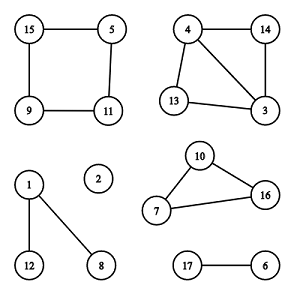You are given an undirected graph consisting of nn vertices and mm edges. Your task is to find the number of connected components which are cycles.
Here are some definitions of graph theory.
An undirected graph consists of two sets: set of nodes (called vertices) and set of edges. Each edge connects a pair of vertices. All edges are bidirectional (i.e. if a vertex aa is connected with a vertex bb, a vertex bb is also connected with a vertex aa). An edge can't connect vertex with itself, there is at most one edge between a pair of vertices.
Two vertices uu and vv belong to the same connected component if and only if there is at least one path along edges connecting uu and vv.
A connected component is a cycle if and only if its vertices can be reordered in such a way that:
- the first vertex is connected with the second vertex by an edge,
- the second vertex is connected with the third vertex by an edge,
- ...
- the last vertex is connected with the first vertex by an edge,
- all the described edges of a cycle are distinct.
A cycle doesn't contain any other edges except described above. By definition any cycle contains three or more vertices.
 There are 66 connected components, 22 of them are cycles: [7,10,16][7,10,16] and [5,11,9,15][5,11,9,15].
There are 66 connected components, 22 of them are cycles: [7,10,16][7,10,16] and [5,11,9,15][5,11,9,15].
The first line contains two integer numbers nn and mm (1≤n≤2⋅1051≤n≤2⋅105, 0≤m≤2⋅1050≤m≤2⋅105) — number of vertices and edges.
The following mm lines contains edges: edge ii is given as a pair of vertices vivi, uiui (1≤vi,ui≤n1≤vi,ui≤n, ui≠viui≠vi). There is no multiple edges in the given graph, i.e. for each pair (vi,uivi,ui) there no other pairs (vi,uivi,ui) and (ui,viui,vi) in the list of edges.
Print one integer — the number of connected components which are also cycles.
5 4
1 2
3 4
5 4
3 5
1
17 15
1 8
1 12
5 11
11 9
9 15
15 5
4 13
3 13
4 3
10 16
7 10
16 7
14 3
14 4
17 6
2
In the first example only component [3,4,5][3,4,5] is also a cycle.
The illustration above corresponds to the second example.
题意:
让你求回路的个数,而且这个回路是没有杂边的单环。
思路
如果有这样的回路,那么每一个节点的度数一定为2。用dfs跑一遍,如果在跑的过程中,所有的点度数均为2,那么它一定就是我们要找的环。
这里我使用了一种新的邻接表,使用vector,这种方式没有办法存储边的长度,但是可以很直接的看出点的度数。如果要用vector来储存权值的话,那么再开一个vector,依次记录就行了
#include<iostream> #include<vector> using namespace std; int book[200005]; int g; vector<int>a[200005]; void dfs(int x) { book[x]=1; if(a[x].size()!=2){g=1;} for(int i:a[x]){ if(!book[i]){dfs(i);} } } int main() { int n,m; cin>>n>>m; int x,y; for(int i=1;i<=m;i++){ cin>>x>>y; a[x].push_back(y); a[y].push_back(x); } int ans=0; for(int i=1;i<=n;i++){ g=0; if(!book[i]){ dfs(i); if(!g){ans++;} } } cout<<ans<<endl; }
以上思路来自于大神代码:






















 350
350

 被折叠的 条评论
为什么被折叠?
被折叠的 条评论
为什么被折叠?








